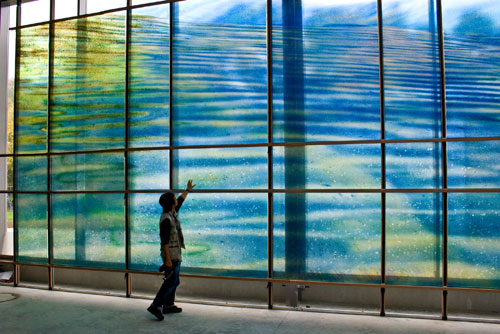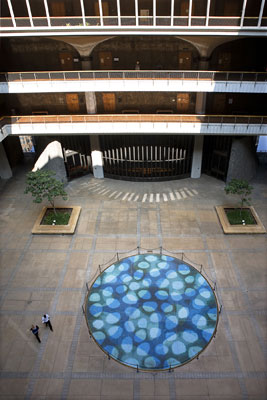Public art turned outside in

Doug Young's painting of western Oahu waters was transformed into a huge, two-layered glass installation at the Judiciary Complex.

Tadashi Sato's famous "Aquarius" mosaic has come to characterize the state Capitol. Sato's project and David Young's painting of western Oahu waters serve as examples of commissioned public artwork in "Architecture: Exploring Public Art & the Built Environment" showing at the Hawaii State Art Museum.


In "ARchiTecture" you’ll see the tides of Lanikuhonua rendered in glass, the stone expressions of Hawaiian titans, intimate and fantastic undersea visions, translations of the effects of light on water, and metal trees that record Maui’s seasonal cycles. Actually, you’ll find models, studies, photographic and video documentaries of such visions, for they are integral parts of various public buildings: the Ronald T.Y. Moon Judiciary Complex in Kapolei, the Capitol rotunda, Maui Community College and the passenger transfer area of Pier 2.
This exhibition of five commissioned works by Satoru Abe, Carol Bennett, Leland Miyano, Tadashi Sato and Doug Young features the most recent fruits of the State Foundation on Culture and the Arts’ Art in Public Places (APP) Program, which is funded by our pioneering Art in State Buildings Law, which sets aside 1 percent of the construction costs of all new buildings for the acquisition of artwork. Curated by APP project managers and local architect David Bylund, this is a behind-the-scenes look at the intensely collaborative creative labor that goes into making public sites feel like people have a stake in them.
The subtle irony is that we often overlook these works of art because when we are in such public spaces, we are focused on more immediate tasks: getting to the next class, exercising our constitutional rights, arriving or departing from paradise, negotiating the legal system or simply getting through another day at work.
"Architecture: Exploring Public Art & The Built Environment" On exhibit: Through Jan. 15, 2011 (resumes May 6 to July 18), 10 a.m. to 4 p.m. Tuesdays to Saturdays |
Consider the Capitol, which trades gray granite and an ornate renaissance dome for a complex mix of Hawaiian essences that evoke volcanoes, the ocean, and alignment according to mountains and sea. The building’s sky-lit axis is Tadashi Sato’s "Aquarius," a swirling circular mosaic of tiny turquoise, blue and green glass cubes that become a rippling ocean pool when viewed from the balconies.
Similarly, no blindfolded statues of Justice with her scales and sword adorn the Judiciary Complex. The architects thought about judgment, intimidation and enclosure and determined that illumination could address all of these spirits. Commissioned artist Doug Young studied the waters of western Oahu and brought them to the building’s windows. A German foundry translated his painting style into two layers of glass: one capturing the reflective quality of a moving wave and another emulating the patterns of sand, stone and coral refracted in shallow depths.
Outside of the complex Leland Miyano’s arrangement of fantastically broken and polished basalt boulders exemplify the critical dialogue that artists can set up with an installation site. Curving concrete pathways divided by sections of grassy landscaping lead pedestrians from parking lots to the complex’s entry. Here Miyano has proposed a philosophical question: How can public art address a system that can break up families in the name of justice, while elsewhere in its machinery protect us from the abuse of power?
Don't miss out on what's happening!
Stay in touch with breaking news, as it happens, conveniently in your email inbox. It's FREE!
Miyano answers with stone hybrids of natural effort and human labor, embodying profound Hawaiian conceptions of law, family, nature’s continuity and balanced masculine and feminine energies. Though few will stop to look at these works, they certainly aren’t going anywhere — the proof is in documentary photographs of massive cranes positioning them. His medium predates the human conception of justice and is guaranteed to outlast the complex itself. His message is deep, hidden and on par with any stone monument that has outlasted its civilizations.
Carol Bennett’s work addresses a space governed by more transient moments but still connects us to long-term natural forces. "Water: A Point of Departure" was commissioned to connect with tourists coming and going on cruise ships docked at Pier 2. Bennett has installed large-scale, vibrantly colored close-ups of tropical fish textures and semiabstract renderings of water and swimmers, painted on recycled sailcoth. She plays a remarkable trick with scale and focus that makes us feel submerged even from a great distance. Her images reinforce our visitors’ memories and the anticipation of their experience in Hawaii.
Satoru Abe’s "Path Through the Trees," located on the campus of Maui Community College, reminds students and teachers of the journey on which they have embarked. Abe’s grove of playful bronze trees surround and dwarf a knee-high abstraction of the island of Maui, multiplying the notion of trees as symbols of wisdom and knowledge. Each paddlelike leaf was refined by hand, on site, and visibly bears the unique traces of his hammer, pliers and blowtorch. These trees will transform under the cyclical influences of wind, heat and water and bear out a more subtle record of time.
We are lucky to live in a place possessing a powerful natural beauty and rich cultural history that demands an expression of harmony from our architects and inspires our artists to dialogue with those powers. While the wealthy can afford to design their private spaces in accordance with what our landscape demands, public buildings are anonymous factories for laws, knowledge, ideas and relationships. Fortunately the state has ensured that "everyone" can experience design derived from thorough and creative consideration of public site, place and space.



